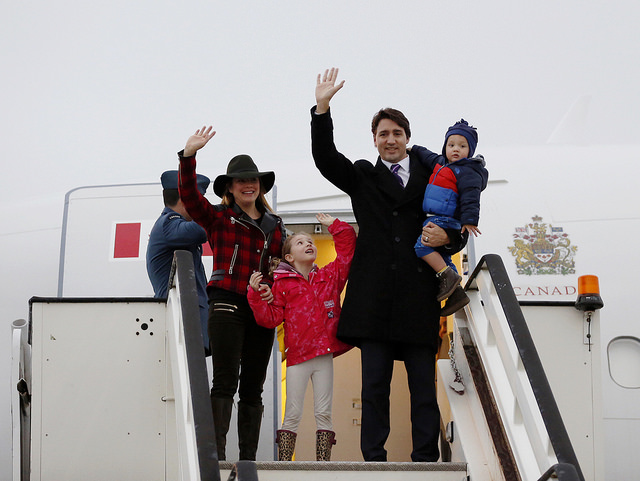rabble is expanding our Parliamentary Bureau and we need your help! Support us on Patreon today!
It was bound to happen. Political honeymoons inevitably hit rough patches.
For Prime Minister Justin Trudeau that rough patch has come in the form of nannies on the federal payroll.
It is not a real scandal.
The federal government pays for all kinds of goods and services public officials might need.
And even if there were anything scandalous about it, it would hardly qualify as major league.
Indeed, what is probably most scandalous about the nanny business is how little the people who care for the prime minister’s children get paid.
From the taxpayers’ point of view, the total amount of money involved is tiny, in the context of the vastness of federal spending.
However, as a friend who grew up in another political culture once commented, Canadians have a great capacity to sweat the small stuff.
That might be because we can all relate more easily to an expenditure of $15-$20 per hour than to the billions a government might waste on ineffective spending …
… Or, the billions governments might, in effect, give away in ill-conceived tax breaks that do not achieve their putative purpose.
Let’s take the corporate income tax, for instance.
What that rate should be was a bit of an issue during the last election.
The Harper Conservatives boasted of having reduced the Canadian corporate tax rate to one of the lowest in the developed world — which, they argued, is good for business investment.
The Liberals agreed.
They promised to keep the federal corporate rate at 15 per cent, where the Harper government had pegged it in 2012.
The NDP argued for a modest and gradual increase to 17 per cent, lower than the average rate over the nearly 10 years of Conservative rule.
Corporate tax rate cuts have not generated growth
The justification for keeping the corporate rate low is that it will create investment and jobs.
The classic economists’ view is that as taxes go down, business investment will increase.
That may not be the case, however.
A new study from the Canadian Centre for Policy Alternatives (CCPA) shows that, in Canada, the promise of jobs and investment in exchange for low corporate taxes has been, mostly, illusory.
In fact, the study’s author Jordan Brennan says, “corporate tax reductions happened alongside under-investment, a job crisis, and deep stagnation … Far from spawning higher levels of business investment and GDP growth, [they] indirectly fostered slower growth.”
Brennan analyzed business investment growth in Canada going back to the 1920s and found that it was highest when the corporate tax rate was also highest, in the mid-1950s.
As the tax rate has dropped, Brennan found, so has investment — the opposite of what mainstream economists tell us should happen.
The CCPA report refers to the 40-odd years following the Second World War as the “pre corporate tax cutting era” and to the period from the late 1980s to the present as the “corporate tax reduction obsessed era” and concludes:
“When we contrast the experience prior to the rate reduction era (1945-1988) with the rate-reduction-obsessed era (1988-2013), we see a move from heightened industrial capacity expansion to capacity stagnation.”
What happened is that instead of investing in job-creating activities major corporations have been sitting on mountains of cash.
Corporate concentration and precarious workers
Brennan argues that large corporations are not motivated by national growth but by “increased margins and deepening of their income share.”
He says, in fact, that corporations might be wary of a full employment scenario in which labour’s bargaining power would increase. Many corporations, he says, believe they have an interest in keeping labour in a precarious state.
Brennan cites the distinguished Polish economist Michal Kalecki who — decades ago during the Great Depression — commented on business’ opposition to government spending to generate jobs.
Why did Big Business oppose measures that would mitigate widespread misery and hunger?
Kalecki’s answer was, “the ‘sack’ would then cease to play its role as a disciplinary measure. The social position of the boss would be undermined and the self-assurance … of the working class would grow.”
Brennan points to a relationship, in Canada, between the frenzy to cut the corporate income tax rate and the trend to corporate concentration.
“That Canada’s largest corporations have doubled their income share in the past two decades in tandem with excessive cash hoarding indicates the growth of corporate power itself might be one determinant of cash stockpiling, and hence of slower growth,” he writes. ” … insofar as corporate tax rate reductions have enabled greater cash hoarding they have indirectly served to dampen growth.”
In other words, if Brennan’s findings are correct, cuts in the corporate tax rate over the past 15 years have had the opposite of their intended effect.
They have not increased investment and economic growth. They have only helped over-sized corporations take up more and more space in the economic landscape.
And those mega-corporations would just as soon stockpile their cash windfalls from tax cuts as invest them.
The cumulative cost in lost revenue to the federal government of ill-conceived corporate tax cuts has been in the multiple billions of dollars.
You could hire whole armies of nannies with that wasted money.
Photo: flickr/ Prime Minister of Canada




